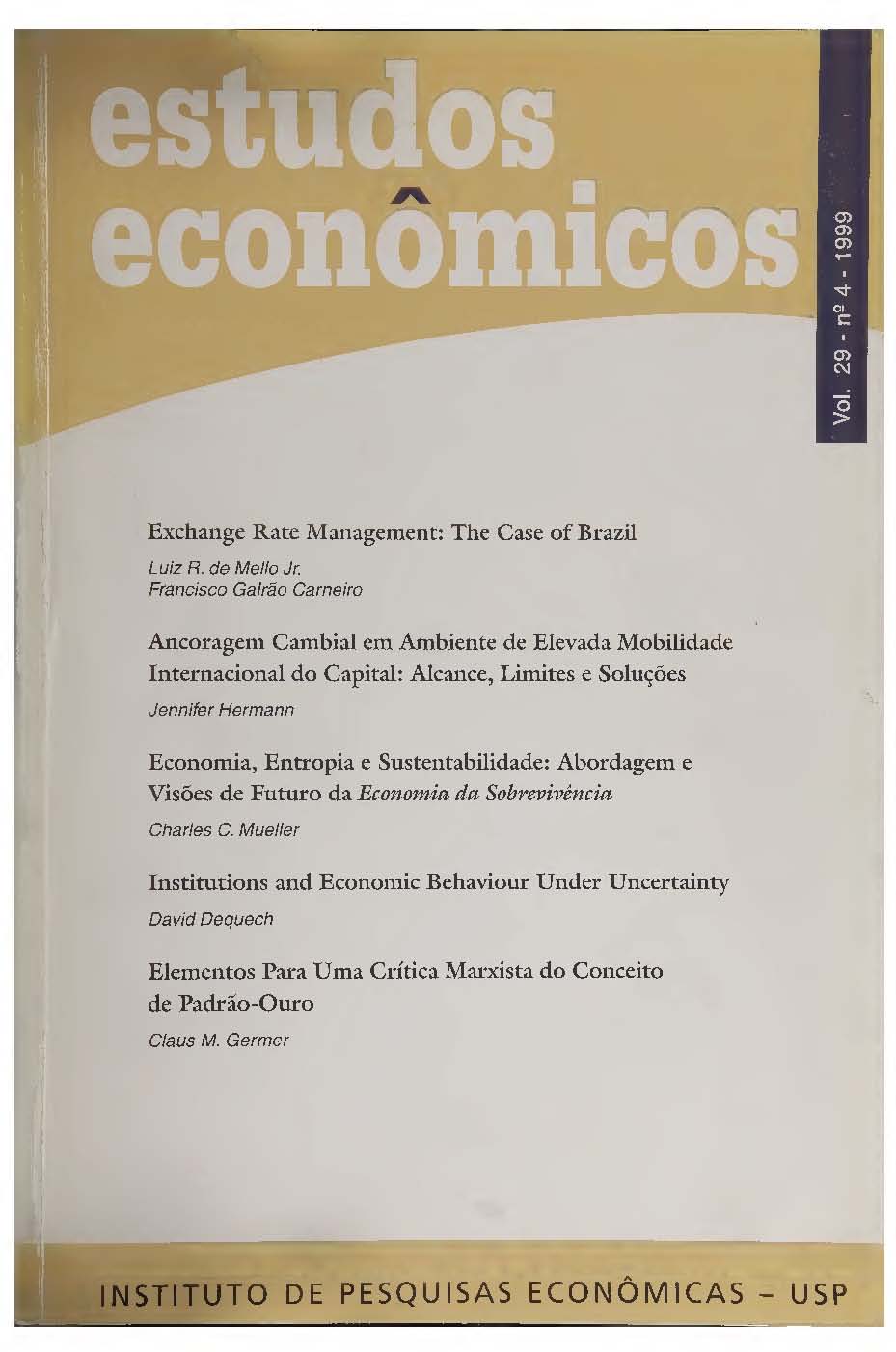Ancoragem cambial em ambiente de elevada mobilidade internacional do capital: alcance, limites e soluções
Keywords:
stabilization, exchange rate regime, capital mobilityAbstract
External fragility, reflected in rising external debt and current account deficits, has become
a common feature of developing countries that recently (1980-90 decades) has
experienced stabilization programs based on nominal exchange rate anchor. The (new)
financial-institucional enviroment of developed contries - creditors of this debt -
characterized by the liberalization process and rising levels of capital mobility, acts as an
"externality" that can aggravate this situation and, hence, implies a permanent concern.
The article discusses two alternative strategies ofmacroeconomic adjustments of the
economies emerging from exchange rate anchor plans: i) adapting (submiting) the short
run policy, maintaining the fixed exchange rate regime; and ii) adjusting (flexibilizing) the
exchange rate regime itself. The difficulties involved in the first way point out the second
one as the more efficient and less risky strategy.
Downloads
References
Agenor, P. & Montiel, P. J. Development macroeconomics. Princeton University Press, 1996.
Arida, P. & Lara Resende, A. Inertial inflation and monetary reform in Brazil. In WILLIAMSON, J. (org.), Inflation and indexation: Argentina, Brazil and Israel. Boston: MIT Press, 1985.
Bacha, E. O Piano Real: uma segunda avaliação. In IPEA/CEPAL, 1997.
Bruno, M. High inflation and the nominal anchors of an open economy. Essays in International Finance, n. 183. Princeton University, June 1991.
Calvo, G. A. & Vegh, C. A. Inflation stabilization and nominal anchors. Research Department, International Monetary Fund, 1992, mimeo.
Carvalho, F. J. Cardim de. Alta infla^ao e hiperinfla^ao: uma visao poskeynesiana. Revista de Economia Politica, v. 10, n. 4, out.-dez. 1994.
Carvalho, F. J. Sistema financeiro internacional: tendencias e perspectivas. Texto para Discussdo IE/UFRJ, 1997.
Cintra, M. A. M. & Freitas, M. C. P. de. Transformafdes institucionais dos sistemas financeiros - um estudo comparado. Sao Paulo: Fapesp/Fundap, 1998.
Corbo, V & HernAndez, L. Macroeconomic adjustment to capital inflows: latin american style versus east asian style. Policy Research Working Paper 1377, The World Bank, November 1994.
Corden, W M. Economic policy, exchange rates and the international system. Chicago: The University of Chicago Press, 1994.
Delbecque, B. Dual exchange rates under pegged interest rate and balance-of-payments crisis. Journal of International Money and Finance, v. 12, p. 170-181, April 1993.
Dooley, M. P. A survey of literature on controls over international capital transactions. IMF Staff Papers, v. 43, n. 4, December 1996.
Dornbush, R. Collapsing exchange rate regimes. Journal of Development Economics, 27, p. 71-83, 1987.
Flood, R. P. & Marion, N. P. Perspectives on the recent currency crisis literature. IMF Working Paper n. 130, September 1998.
Franco, G. H. B. Alternativas de estabiliza^ao: gradualismo, dolarização e populismo. In: FRANCO, G. H. B. (org.), O Piano Real e outros ensaios. Rio de Janeiro: Francisco Alves, 1995.
Hull, J. Introdugdo aos mercados futures e de opgoes. Sao Paulo: BM&F/Cultura
Ed. Associados, 1994.
IMF (International Monetary Fund). Mexican foreign exchange market crises from the perspective of the speculative attack literature. World Economic Outlook, 1996, Ch. III.
IPEA/CEPAL. O Plano Real e outras experiências internacionais de estabilização. 1997.
Keynes, J. M. A teoriageral do emprego, dojuro e da moeda. Sao Paulo: Nova Cultural, 1985.
Kiguel, M. A. & Liviatan, N. When do heterodox stabilization programs work? The World Bank Research Observer, v. 7, n. 1, p. 35-57, January 1992a.
Kiguel, M. A. & Liviatan, N. The business cycle associated with exchange rate-based stabilizations. The World Bank Economic Review, v. 6, n. 2, p. 279-305, 1992b.
Krugman, P. A model of balance-of-payments crises. Journal ofMoney, Credit and Banking, 11-3, p. 311-325, August 1979.
Krugman, P. Currencies and crises. London: The MIT Press, 1998, p. 61-76.
Krugman, P. International aspects of financial crises. In: Feldstein, Martin (ed.), The risk of economic crisis. Chicago; University of Chicago Press, 1991, p. 85-108.
Lopes, F. Inflação inercial, hiperinflação e desinflação: notas e conjecturas. In: LOPES, F. (org.), Choque heterodoxo. Sao Paulo: Campus, 1986.
Machinea, J. L. Uma reflexao a meio caminho: dois anos de conversibilidade. In: IPEA/CEPAL, 1997.
Meller, P. A politica anti-inflacionaria chilena da decada de 90. In: IPEA/CEPAL, 1997.
Nogueira Batista Jr., P. O Piano Real a luz da experiencia mexicana e argentina. Estudos Avançados, 10, 28, 1996.
Pires de Souza, E E. Lições de experiências de políticas de estabilização baseadas na ancora cambial. Revista Brasileira de Comercio Exterior. Ago-Set. 1994.
Rodriguez, C. A. The Argentine stabilization plan of december 20th". World Development, 10, n. 9, 1982.
Ros, J. Inflação e estabilização da economia mexicana. In: IPEA/CEPAL, 1997.
Simonsen, M. H. A politica anti-inflacionaria. In: SIMONSEN, M. H. & CAMPOS, R. (orgs.), A moderna economia brasileira. Rio de Janeiro; Jose Olympic, 1975.
Downloads
Published
Issue
Section
License
Copyright (c) 1999 Jennifer Hermann

This work is licensed under a Creative Commons Attribution-NonCommercial 4.0 International License.
By submitting an article, the author authorizes its publication and attests that it has not been submitted to any other journal. The original article is considered final. Articles selected for publication are proofread for grammatical and orthographic errors. The journal does not pay rights for published articles. The Institute of Economic Research from the School of Economics, Business and Accounting of the University of São Paulo (Instituto de Pesquisas Econômicas da Faculdade de Economia, Administração e Contabilidade da Universidade de São Paulo) owns the journal's copyright.




